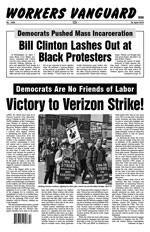
In Honor of the Dublin Easter Rising (Letters) New York, NY Dear Comrades, This year marks the 100th anniversary of the Easter Rebellion of the people who arose against the British occupation in 1916. They attempted to establish a Socialist Republic as part of the world-wide Socialist Revolution to overthrow capitalism. This was a major event of the workers’ movement at the time, which inspired working people all over the world. In Solidarity, WV replies: On 24 April 1916, over a thousand men and women of the Irish Volunteers and the Irish Citizen Army (ICA) staged an armed insurrection in Dublin against British colonial rule. Patrick Pearse read the Proclamation of the Irish Republic outside the General Post Office (GPO), which the rebels occupied along with several other positions across the city. We honor the Easter Rising as a fight for independence of an oppressed nation from Britain amid the bloodshed of WWI. The republic that was declared was not, however, a socialist republic and the rising was not a socialist revolution. The Proclamation, which invoked God twice, said not a word about socialism or the working class. Revolutionary socialist James Connolly, head of the ICA and general secretary of the Irish Transport and General Workers’ Union, was a signatory of the Proclamation and a leader of the uprising. The ICA was formed as a workers militia during the 1913 Dublin Lockout, when the city’s employers locked out union members for five months, starving them into submission. Thus, working-class militants played a role in the 1916 rising, but the proletariat was not mobilized to fight to take power in its own name and served as an auxiliary to the bourgeois-nationalist Irish Volunteers. Connolly was known for his socialist internationalism, but the betrayal by social-democratic parties, particularly in Britain and Germany, in supporting the interimperialist war took a toll on Connolly. He began to despair about the prospects of British workers revolting against their own rulers and made a political bloc with Irish nationalists. Subsequently, the social-chauvinist British Labour Party leaders stridently denounced the Easter Rising. After five days of fighting and heavy shelling from a gunboat that started fires and destroyed much of the center of Dublin, the insurgents were forced to unconditionally surrender to the British forces. Two hundred civilians had been killed by British troops, and the military authorities moved swiftly and mercilessly over the next two weeks to court-martial and execute the leaders of the Rising, whose bodies were buried in quicklime. Connolly was executed tied to a chair because the wounds he had suffered in the GPO had left him unable to stand. While popular support for the Rising had been limited at the outset—most people did not even know what was afoot—the brutal repression and mass arrests spurred many more to oppose colonial rule. Despite its defeat, the Easter Rising was a signal event in the struggle for Irish freedom, which led to the independence of 26 of the 32 counties of Ireland in 1921. In this regard, there is a parallel to the heroic raid by John Brown and his fellow abolitionist fighters on the U.S. military arsenal at Harpers Ferry, Virginia, in 1859. Both were harbingers of events to unfold and were clarion calls for the liberation of the oppressed. Harpers Ferry was the prelude to the American Civil War (1861-65) during which the Union soldiers who smashed the system of chattel slavery sang “John Brown’s Body” on the march. Lenin understood that the events in Dublin were part of the struggles unleashed by WWI and that under imperialism rebellions against national oppression could spark broader struggles (see “Lenin on the 1916 Irish Rebellion” below). This understanding was a key component of the program of Lenin’s Bolsheviks, who led the working class to power in Russia in 1917, overthrowing the capitalists and landlords and beginning the liberation of the oppressed nationalities of the tsarist “prison house of peoples.”
|
|
||||||||||||||||||||||||||||||||||||||||||||||||
